The Effect of Dynamic Lighting for Working Shift People on Clinical Heart Rate Variability and Human Slow Wave Sleep
Abstract
:Featured Application
Abstract
1. Introduction
2. Materials and Methods
2.1. Development of Novel Hypnotic Lighting System
2.2. Experimental Limits and Regulations
2.3. Experimental Design
3. Results
3.1. Heart Rate Variability (HRV) Data
3.2. Work-Efficient Data
3.3. Questionnaire Data
4. Discussion
4.1. The Effect of Different Sleeping Environment on Heart Rate Variability
4.2. Volunteers and Non-volunteers Correlation
4.3. The Transformation of Dynamic Hypnotic Light
5. Conclusions
Author Contributions
Funding
Institutional Review Board Statement
Informed Consent Statement
Data Availability Statement
Conflicts of Interest
References
- Shalala, D.E.; Satcher, D.; Lee, P.R.; Joyner, F.G.; McMillen, T. Physical Activity and Health: A Report of the Surgeon General; US Department of Health and Human Services: Washington, DC, USA, 1996; p. 278.
- Kang, M.G.; Koh, S.B.; Cha, B.S.; Park, J.K.; Baik, S.K.; Chang, S.J. Job stress and cardiovascular risk factors in male workers. Prev. Med. 2005, 40, 583–588. [Google Scholar] [CrossRef] [PubMed]
- Mika, K.; Virtanen, M.; Elovainio, M.; Kouvonen, A.; Väänänen, A.; Vahtera, J. Work stress in the etiology of coronary heart disease a meta analysis. Scand. J. Work Environ. Health 2006, 32, 431–442. [Google Scholar]
- Mika, K. Job strain as a risk factor for coronary heart disease: A collaborative meta-analysis of individual participant data. Lancet 2012, 380, 1491–1497. [Google Scholar]
- Nakata, A.; Haratani, T.; Takahashi, M.; Kawakami, N.; Arito, H.; Kobayashi, F.; Araki, S. Job stress, social support, and prevalence of insomnia in a population of Japanese daytime workers. Soc. Sci. Med. 2004, 59, 1719–1730. [Google Scholar] [CrossRef] [PubMed]
- Ota, A.; Masue, T.; Yasuda, N.; Tsutsumi, A.; Mino, Y.; Ohara, H. Association between psychosocial job characteristics and insomnia: An investigation using two relevant job stress models—the demand-control-support (DCS) model and the effort-reward imbalance (ERI) model. Sleep Med. 2005, 6, 353–358. [Google Scholar] [CrossRef] [PubMed]
- Ota, A.; Masue, T.; Yasuda, N.; Tsutsumi, A.; Mino, Y.; Ohara, H.; Ono, Y. Psychosocial job characteristics and insomnia: A prospective cohort study using the Demand-Control-Support (DCS) and Effort–Reward Imbalance (ERI) job stress models. Sleep Med. 2009, 10, 1112–1117. [Google Scholar] [CrossRef]
- Kim, H.-C.; Kim, B.-K.; Min, K.-B.; Min, J.-Y.; Hwang, S.-H.; Park, S.-G. Association between job stress and insomnia in Korean workers. J. Occup. Health 2011, 53, 164–174. [Google Scholar] [CrossRef] [PubMed] [Green Version]
- Jackowska, M.; Dockray, S.; Endrighi, R.; Hendrickx, H.; Steptoe, A. Sleep problems and heart rate variability over the working day. J. Sleep Res. 2012, 21, 434–440. [Google Scholar] [CrossRef]
- Bonnet, M.H.; Arand, D.L. Heart rate variability: Sleep stage, time of night, and arousal influences. Electroencephalogr. Clin. Neurophysiol. 1997, 102, 390. [Google Scholar] [CrossRef]
- Bonnet, M.H.; Arand, D.L. Heart Rate Variability in Insomniacs and Matched Normal Sleepers. Psychosom. Med. 1998, 60, 610. [Google Scholar] [CrossRef] [PubMed]
- Spiegelhalder, K.; Fuchs, L.; Ladwig, J.; Kyle, S.D.; Nissen, C.; Voderholzer, U.; Feige, B.; Riemann, D. Heart rate and heart rate variability in volunteersively reported insomnia. J. Sleep Res. 2011, 20, 137. [Google Scholar] [CrossRef] [PubMed]
- Shinar, Z.; Baharav, A.; Akselrod, S. Obstructive Sleep Apnea Detection Based on Electrocardiogram Analysis. Comput. Cardiol. 2000, 27, 757. [Google Scholar]
- Shinar, Z.; Akselrod, S.; Dagan, Y.; Baharav, A. Autonomic changes during wake–sleep transition: A heart rate variability based approach. Auton. Neurosci. Basic Clin. 2006, 130, 17. [Google Scholar] [CrossRef] [PubMed]
- Ong, J.L.; Lo, J.C.; Chee, N.I.; Santostasi, G.; Paller, K.A.; Zee, P.C.; Chee, M.W.L. Effects of phase-locked acoustic stimulation during a nap on EEG spectra and declarative memory consolidation. Sleep Med. 2016, 20, 88–97. [Google Scholar] [CrossRef] [Green Version]
- James, J.S.; Umunna, S.; Bretl, T. The elicitation of steady-state visual evoked potentials during sleep. Psychophysiology 2017, 54, 496–507. [Google Scholar]
- Ingegärd, E.M. A Review of Biomarkers in Leadership Research—Can Heart Rate Variability be a Suitable Method? Karolinska Institutet 2007, LIME. [Google Scholar]
- Badia, P.; Myers, B.; Boecker, M.; Culpepper, J.; Harsh, J. Bright light effects on body temperature, alertness, EEG and behavior. Physiol. Behav. 1991, 50, 583–588. [Google Scholar] [CrossRef]
- Liu, N. Effects of Monochromatic LED Blue Light Irradiation on Circadian Rhythm in Healthy Humans. Chin. J. Tissue Eng. Res. 2009, 30, 5923–5926. [Google Scholar]
- Sharon, O.; Nir, Y. Attenuated Fast Steady-State Visual Evoked Potentials During Human Sleep. Cereb. Cortex 2018, 28, 1297–1311. [Google Scholar] [CrossRef] [PubMed]
- West, K.E.; Jablonski, M.R.; Warfield, B.; Cecil, K.S.; James, M.; Ayers, M.A.; Maida, J.; Bowen, C.; Sliney, D.H.; Rollag, M.D.; et al. Blue light from light-emitting diodes elicits a dose-dependent suppression of melatonin in humans. J. Appl. Physiol. 2011, 110, 619–626. [Google Scholar] [CrossRef] [Green Version]
- Global, L.A. Optical and Photobiological Safety of LED, CFLs and Other High Efficiency General Lighting Sources. A White Paper of the Global Lighting Association, March 2012. Available online: http://docplayer.net/13709395-Optical-and-photobiological-safety-of-led-cfls-and-other-high-efficiency-general-lighting-sources-a-white-paper-of-the-global-lighting-association.html (accessed on 15 February 2022).
- Hsieh, C.H.; Huang, B.R.; Wu, P.J.; Chen, C.Y. Colour Deviation Sensing and Compensation Method for Multi-Spectral LED Lighting System. In Proceedings of the CIE 2018 Conference on Smart Lighting, PO17, Taipei City, Taiwai, 24–28 April 2018; pp. 17–28. [Google Scholar]
- Chen, C.Y. Improvement of Sleep Quality by Using an Intelligent Light. In Proceedings of the CIE 28th Session, Manchester, UK, 28 June–4 July 2015. [Google Scholar]
- Hsieh, B.H. Can short breaks with a dynamic light make people fully energetic? In Proceedings of the CIE Midterm Meeting 2017, PO106, Jeju, Korea, 25 October 2017; pp. 1181–1184. [Google Scholar]
- Saul, J.P.; Arai, Y.; Berger, R.D.; Lilly, L.S.; Colucci, W.S.; Cohen, R.J. Assessment of autonomic regulation in chronic congestive heart failure by heart rate spectral analysis. Am. J. Cardiol. 1988, 61, 1292–1299. [Google Scholar] [CrossRef]
- Ako, M.; Kawara, T.; Uchida, S.; Miyazaki, S.; Nishihara, K.; Mukai, J.; Hirao, K.; Ako, J.; Okubo, Y. Correlation between electroencephalography and heart rate variability during sleep. Psychiatry Clin. Neurosci. 2003, 57, 59–65. [Google Scholar] [CrossRef] [PubMed]
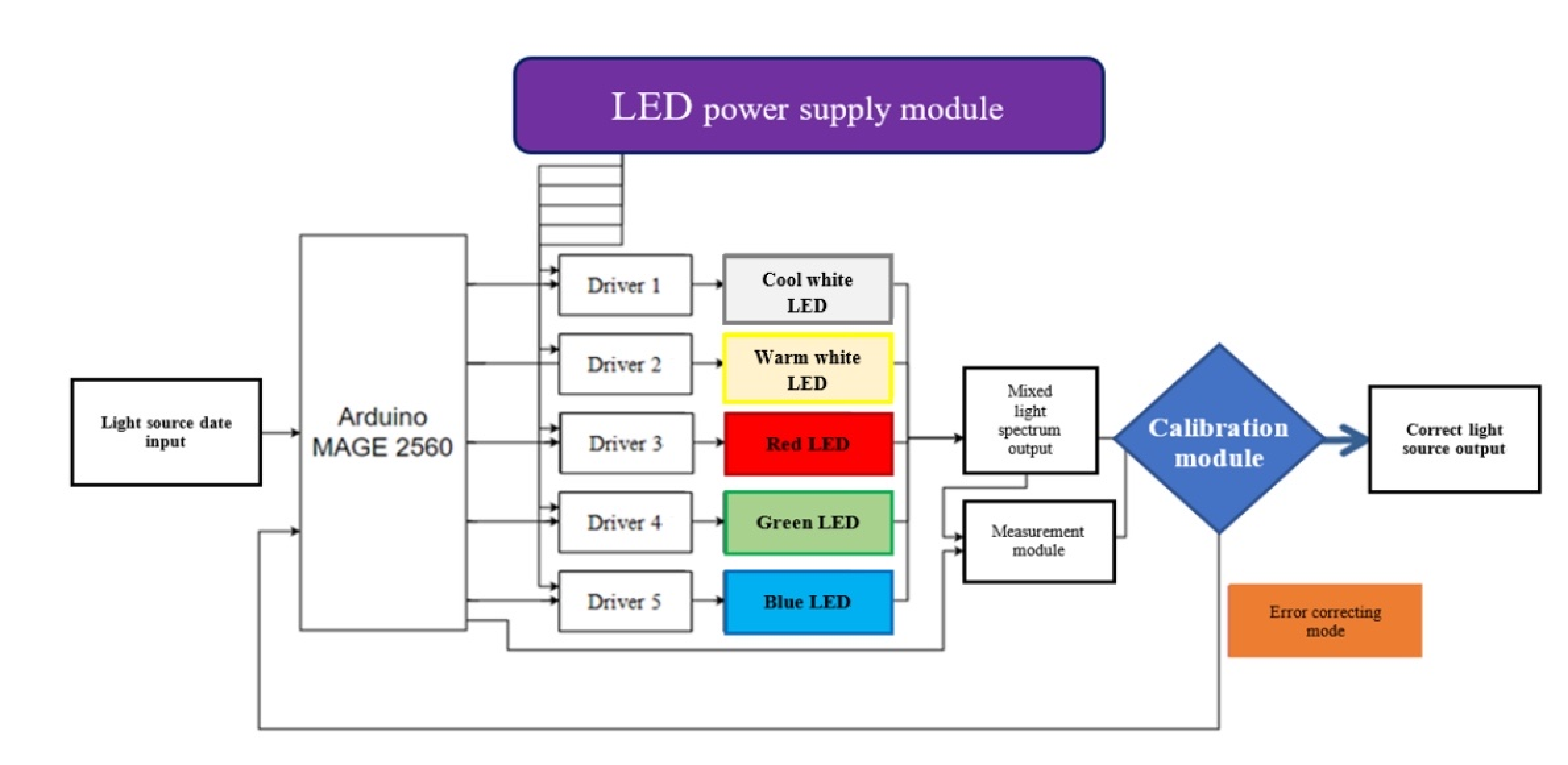
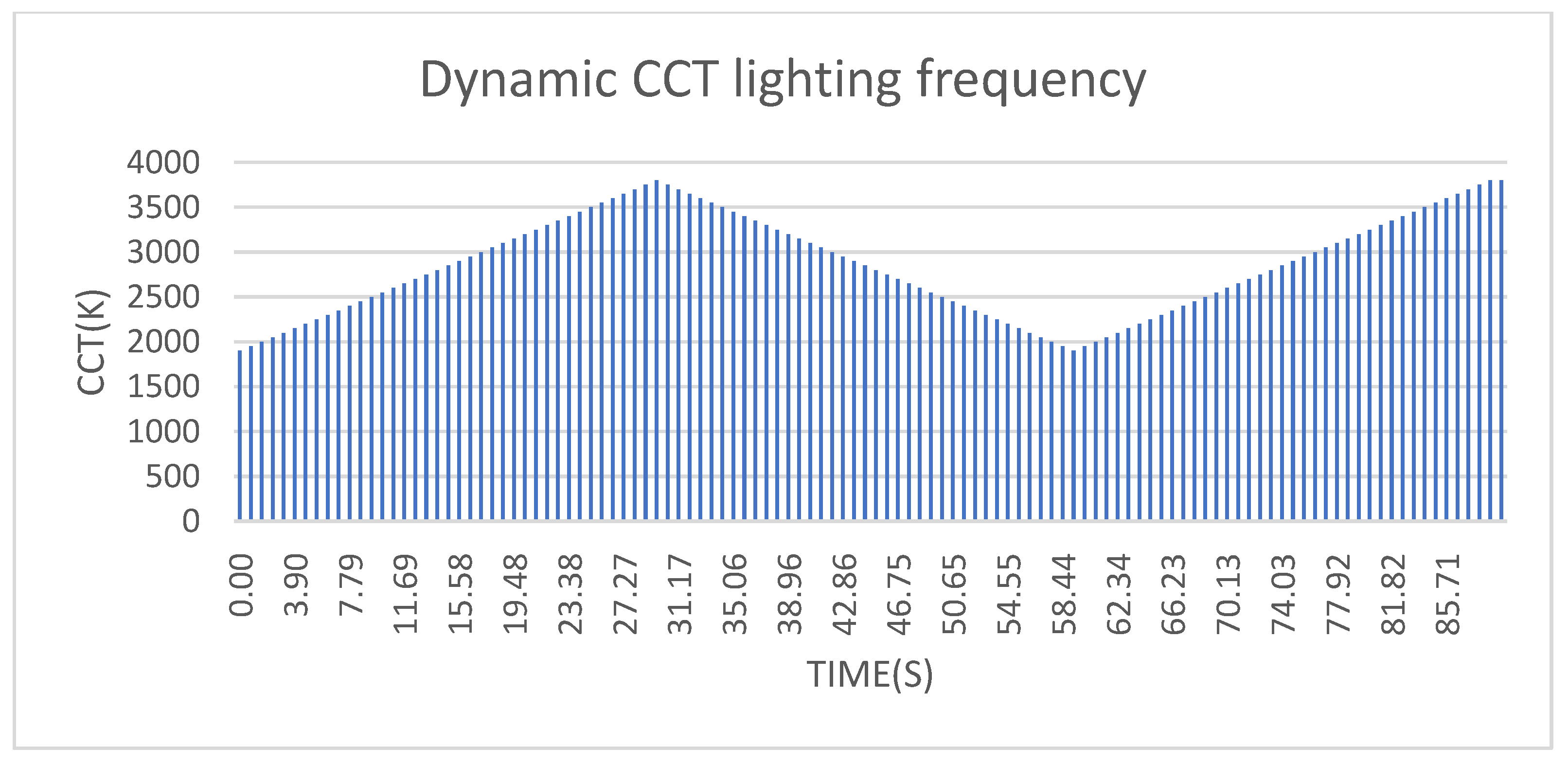
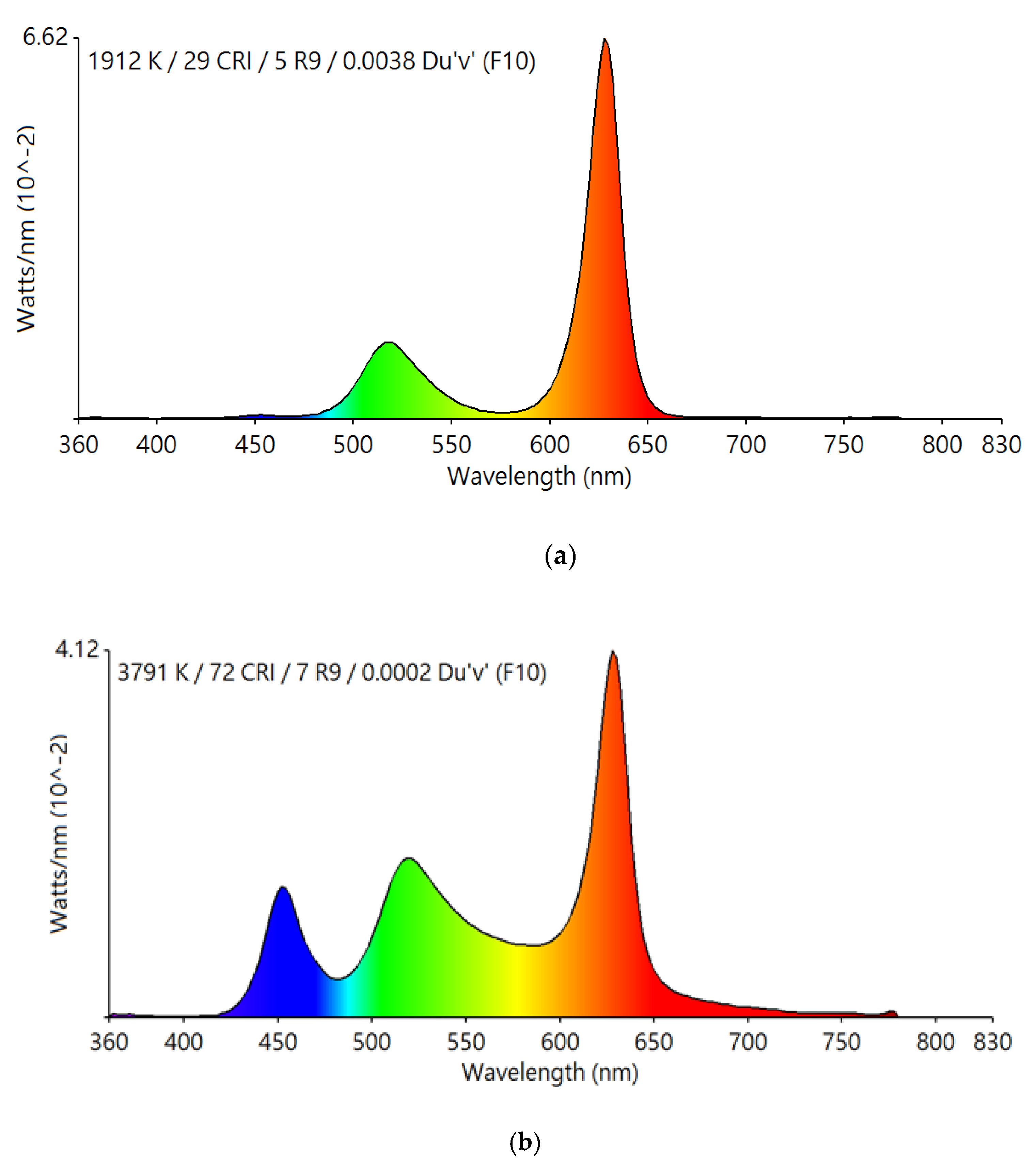
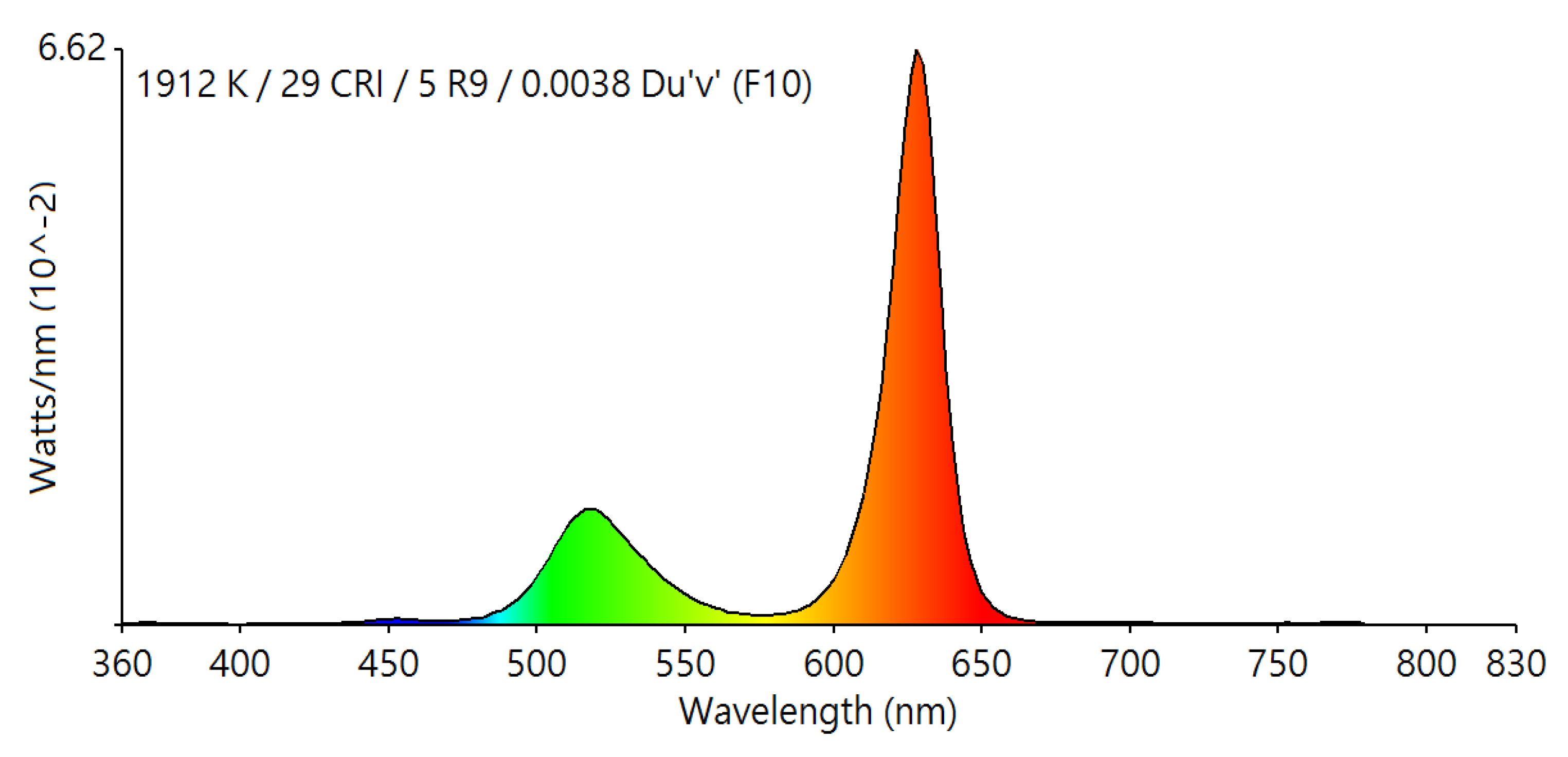
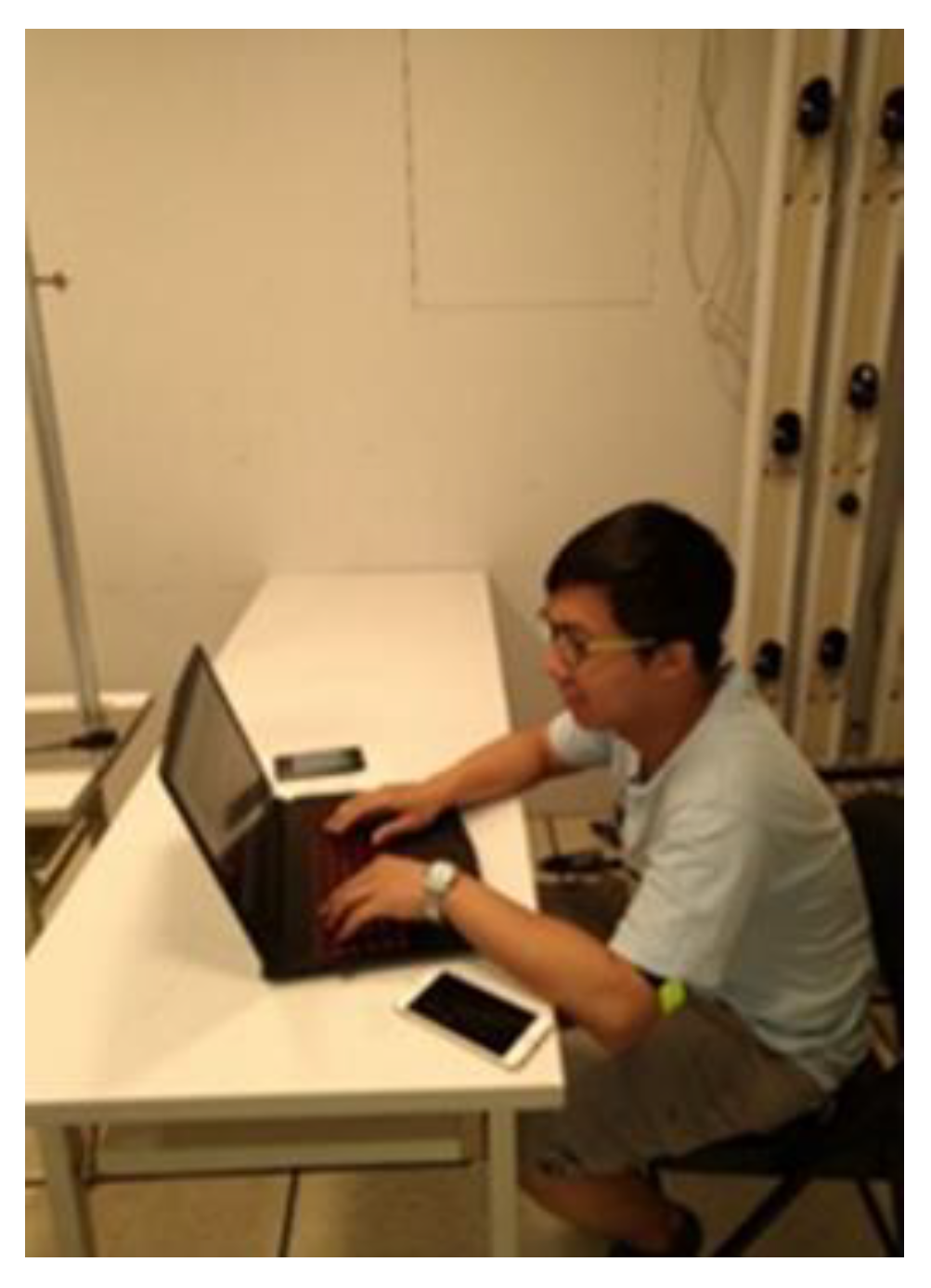
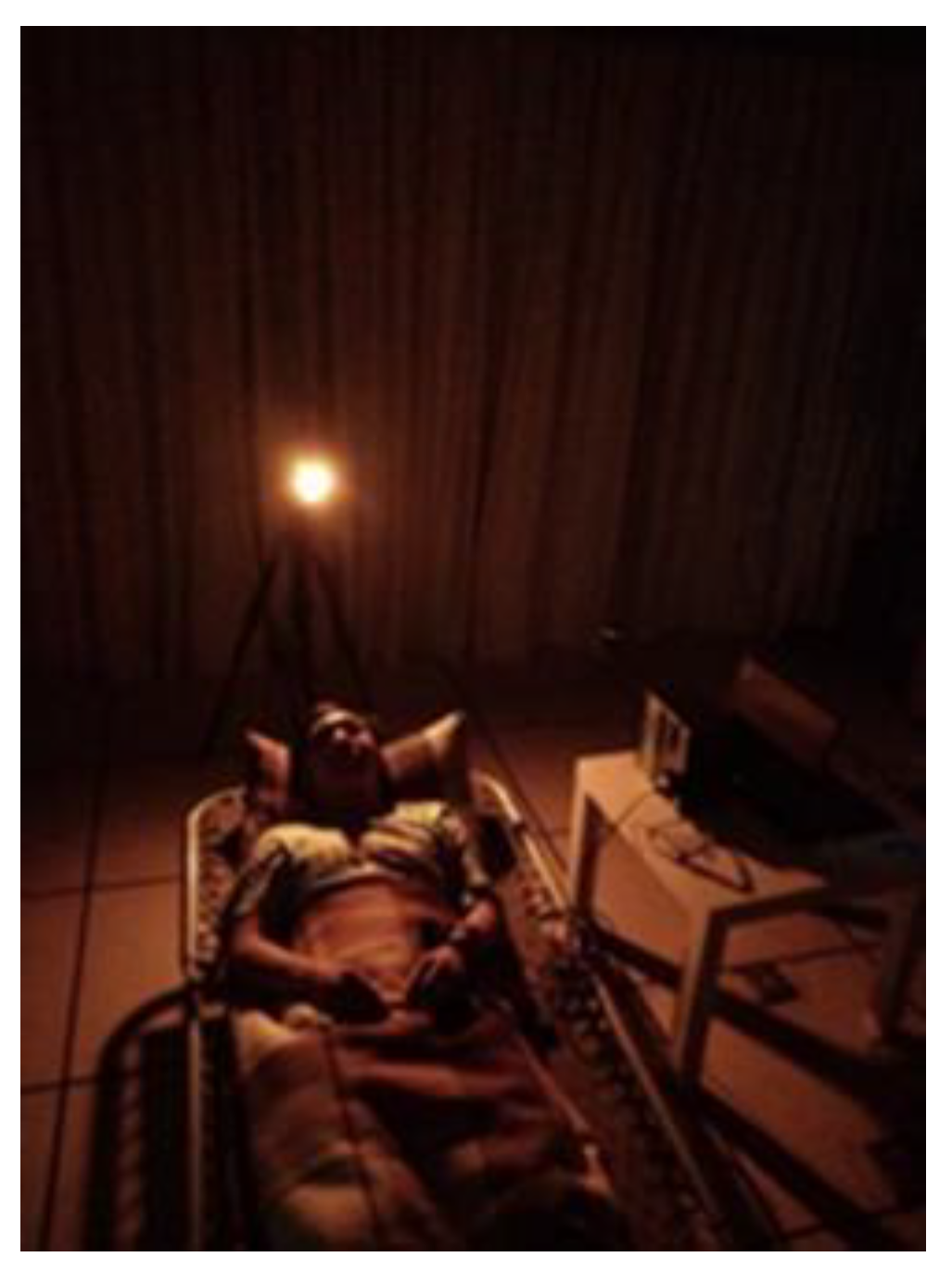
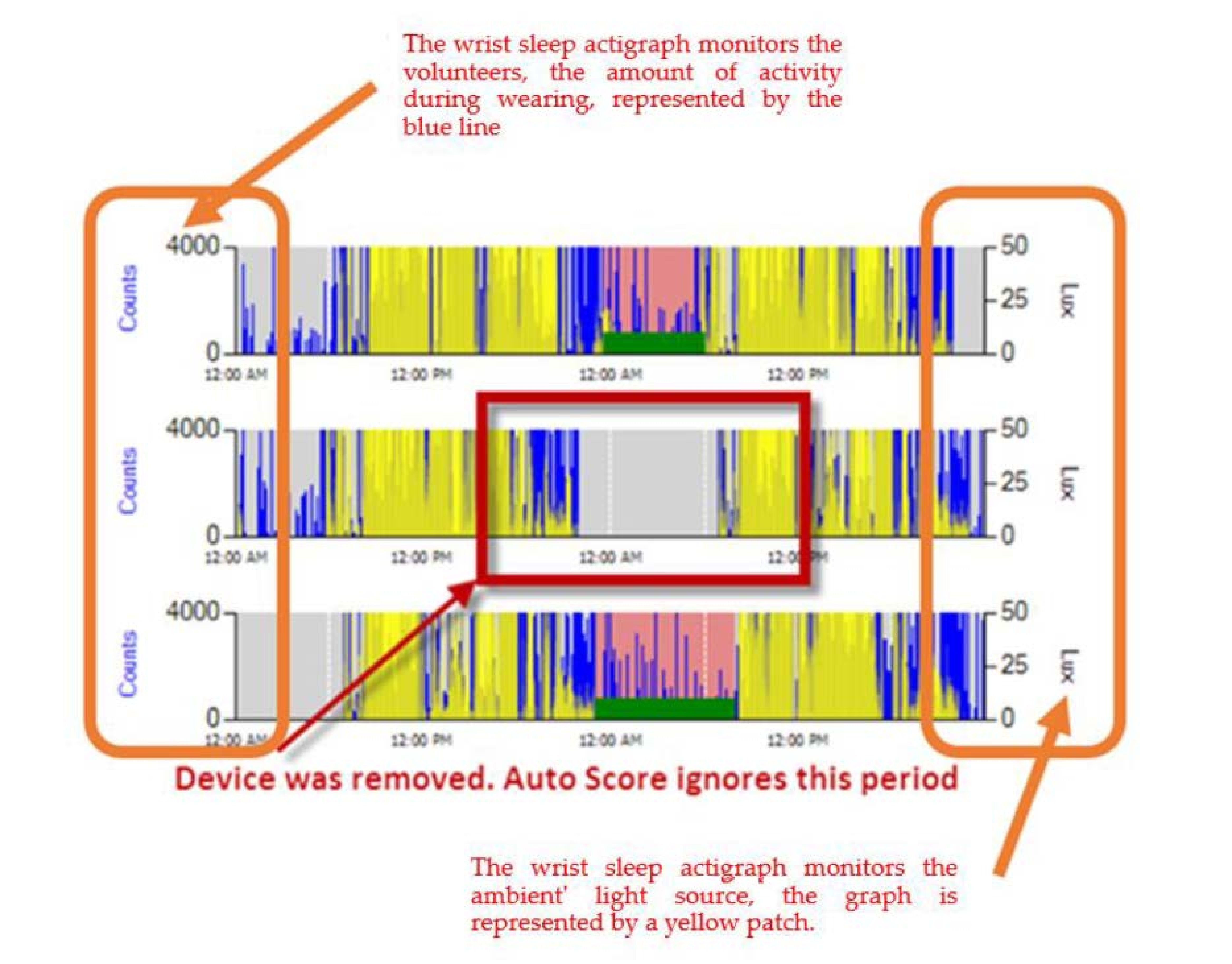
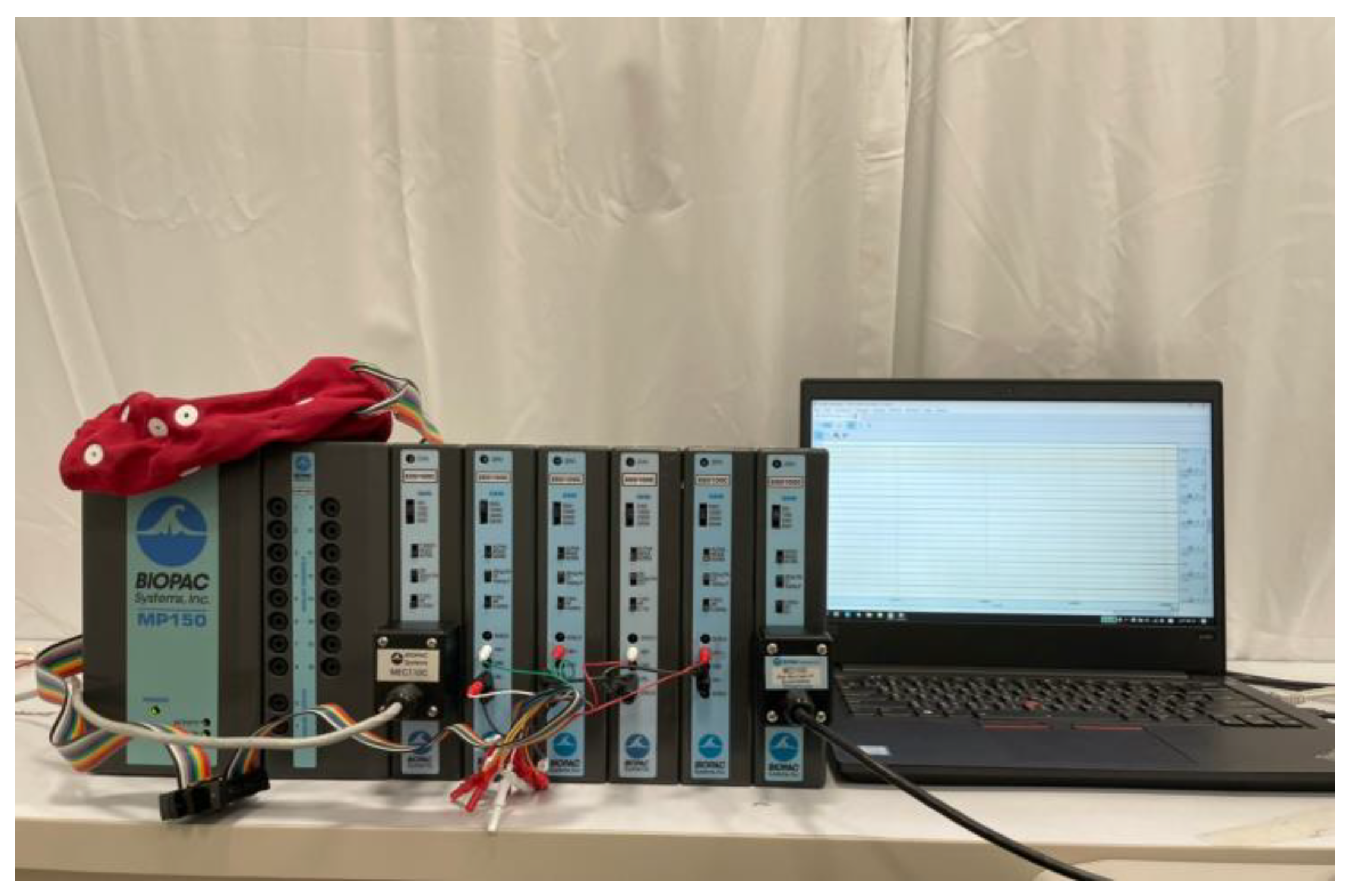
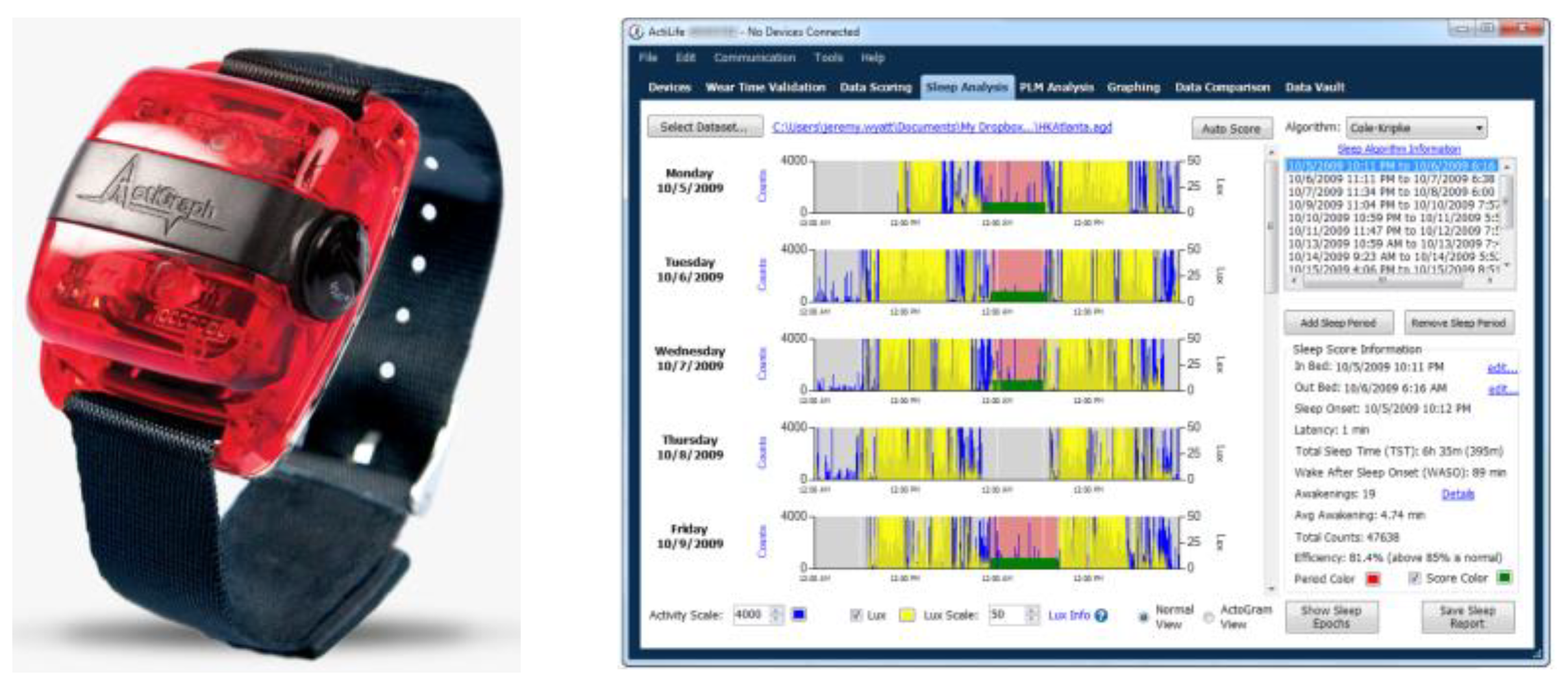
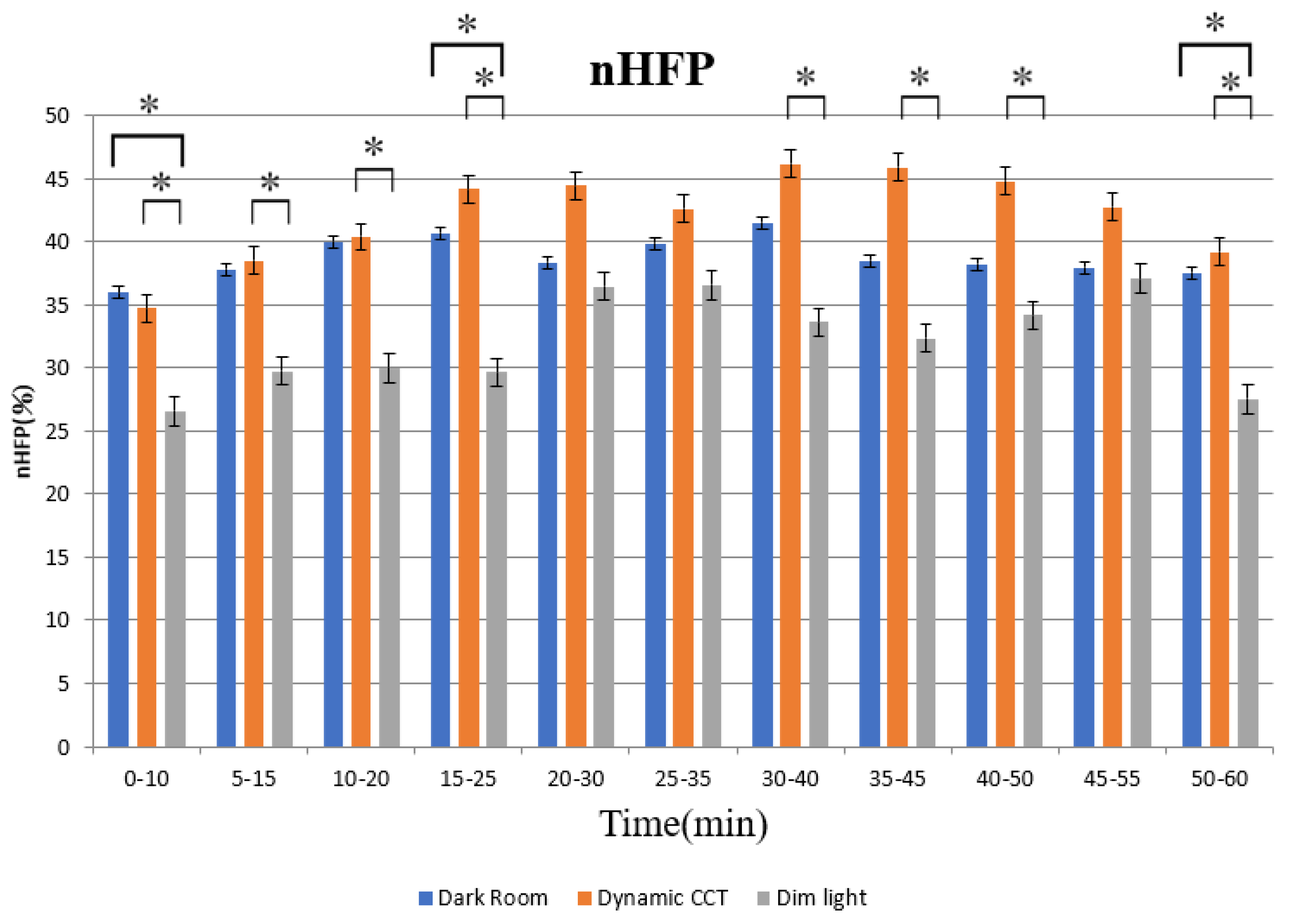
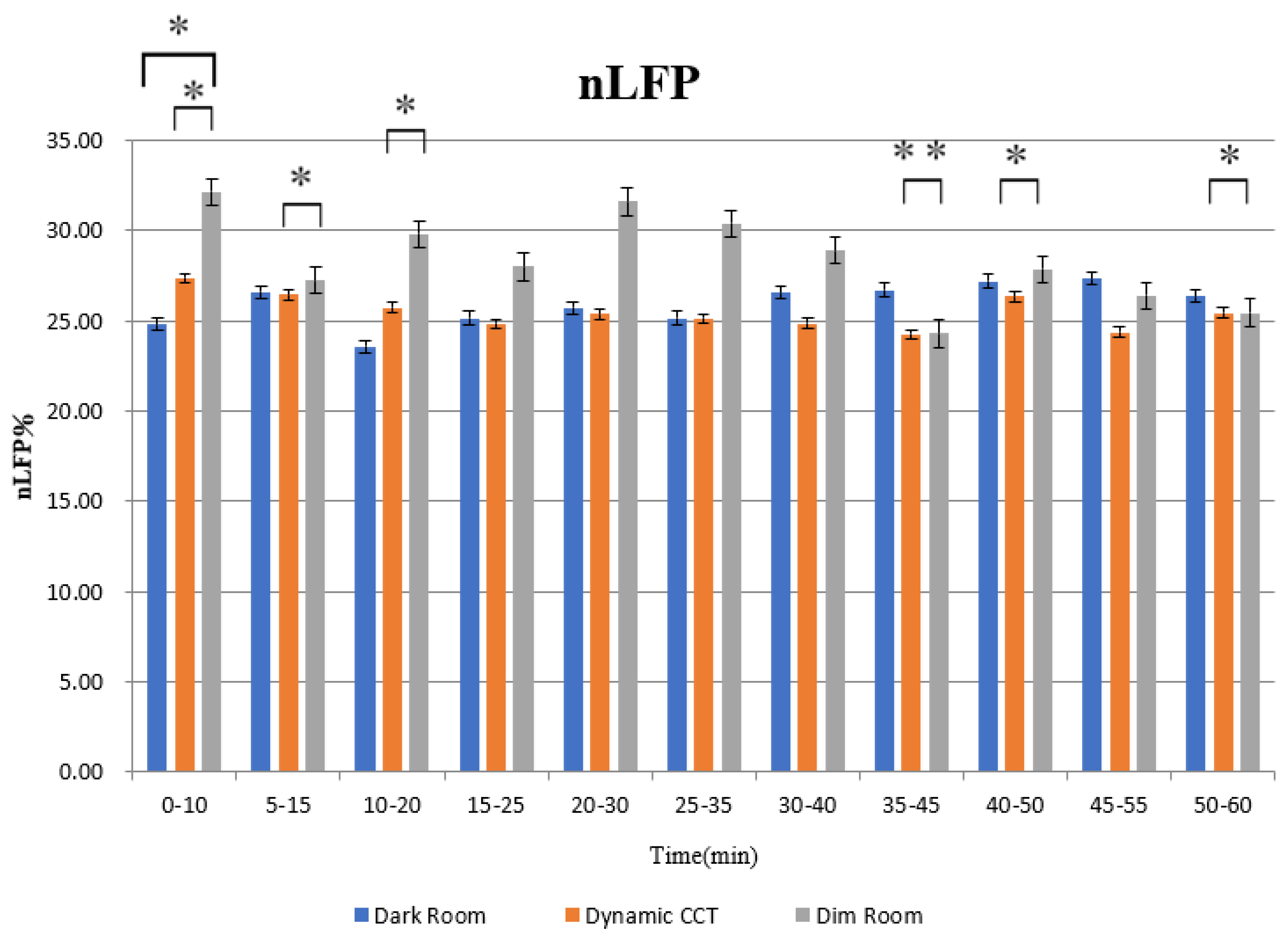
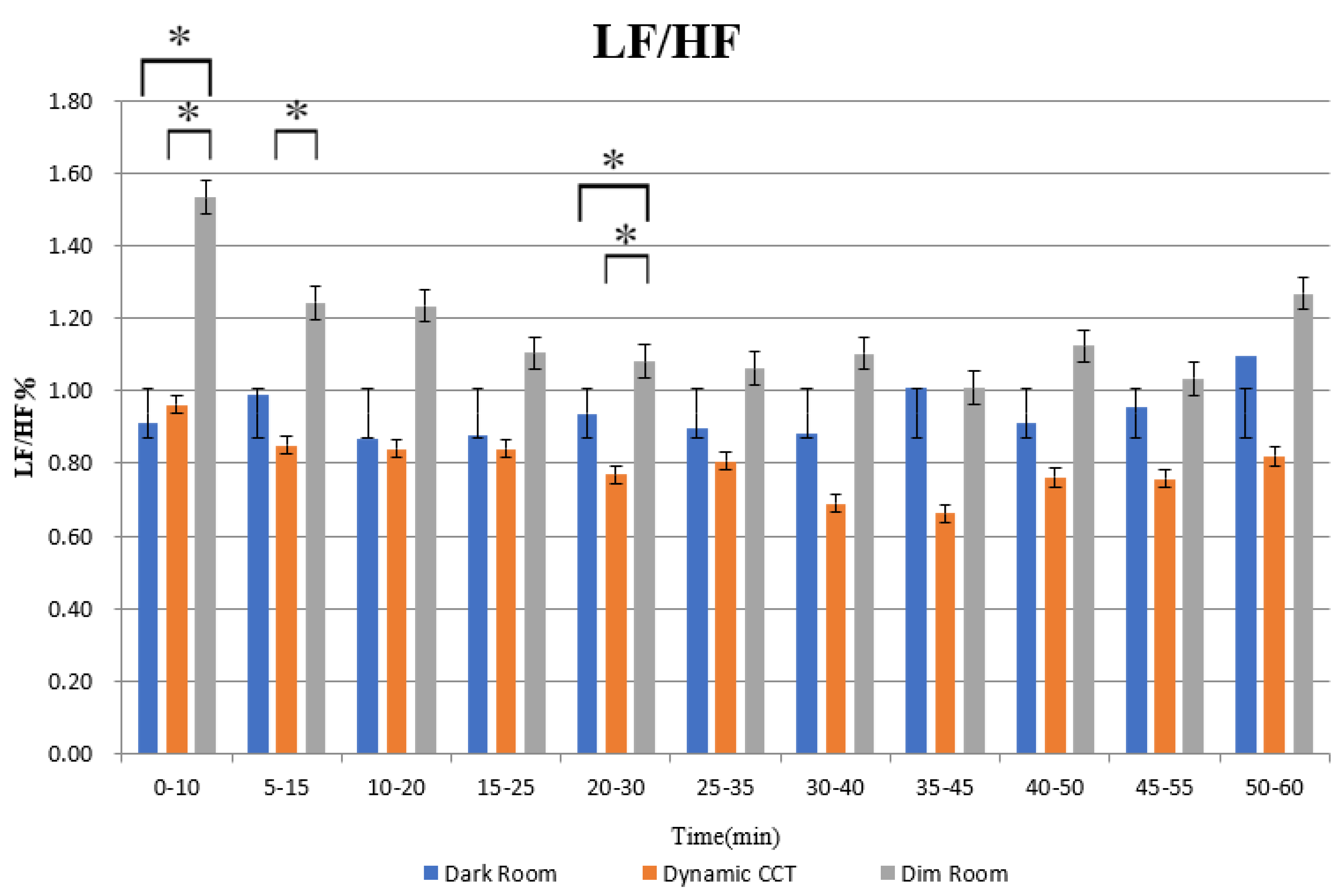
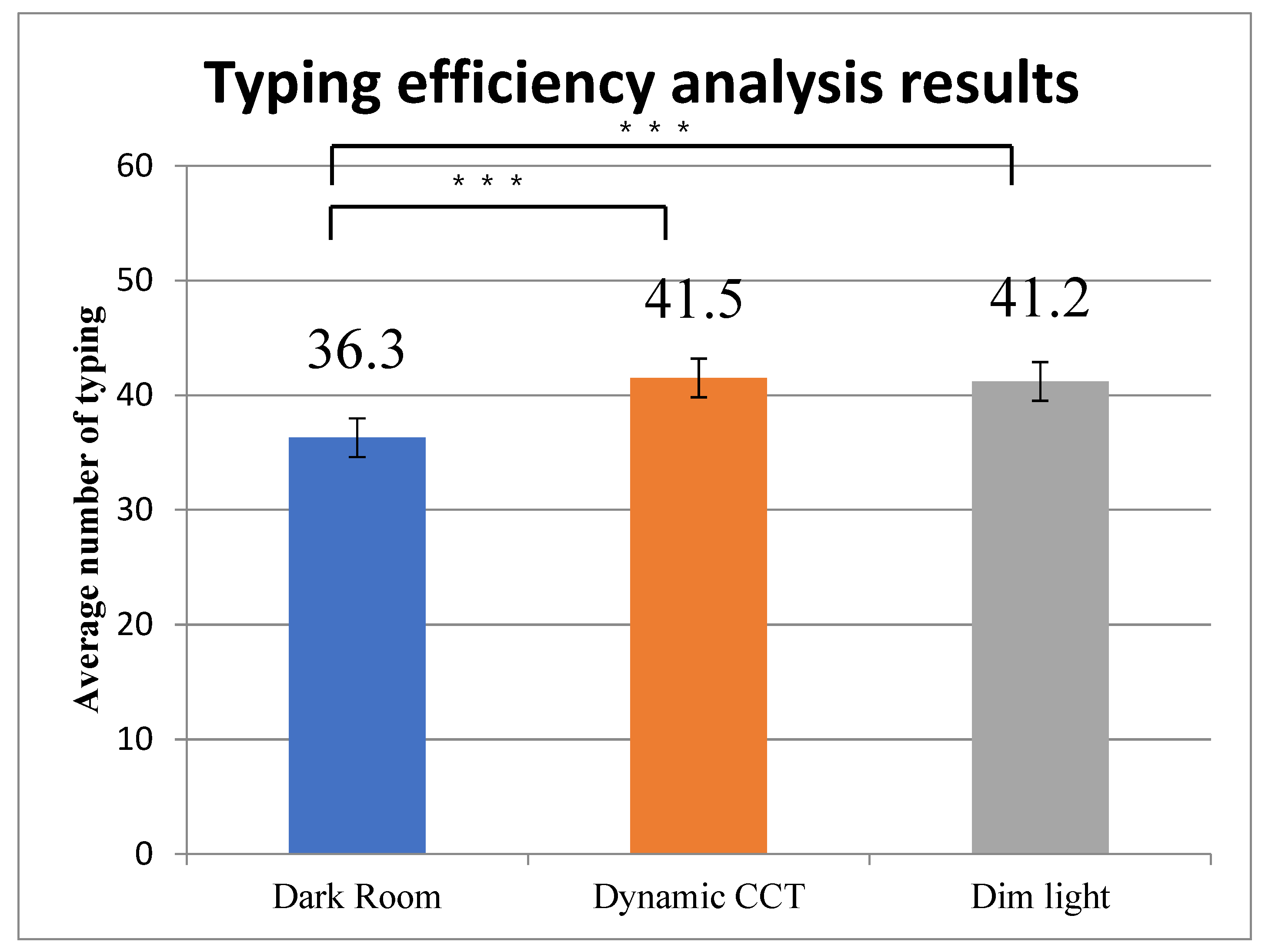
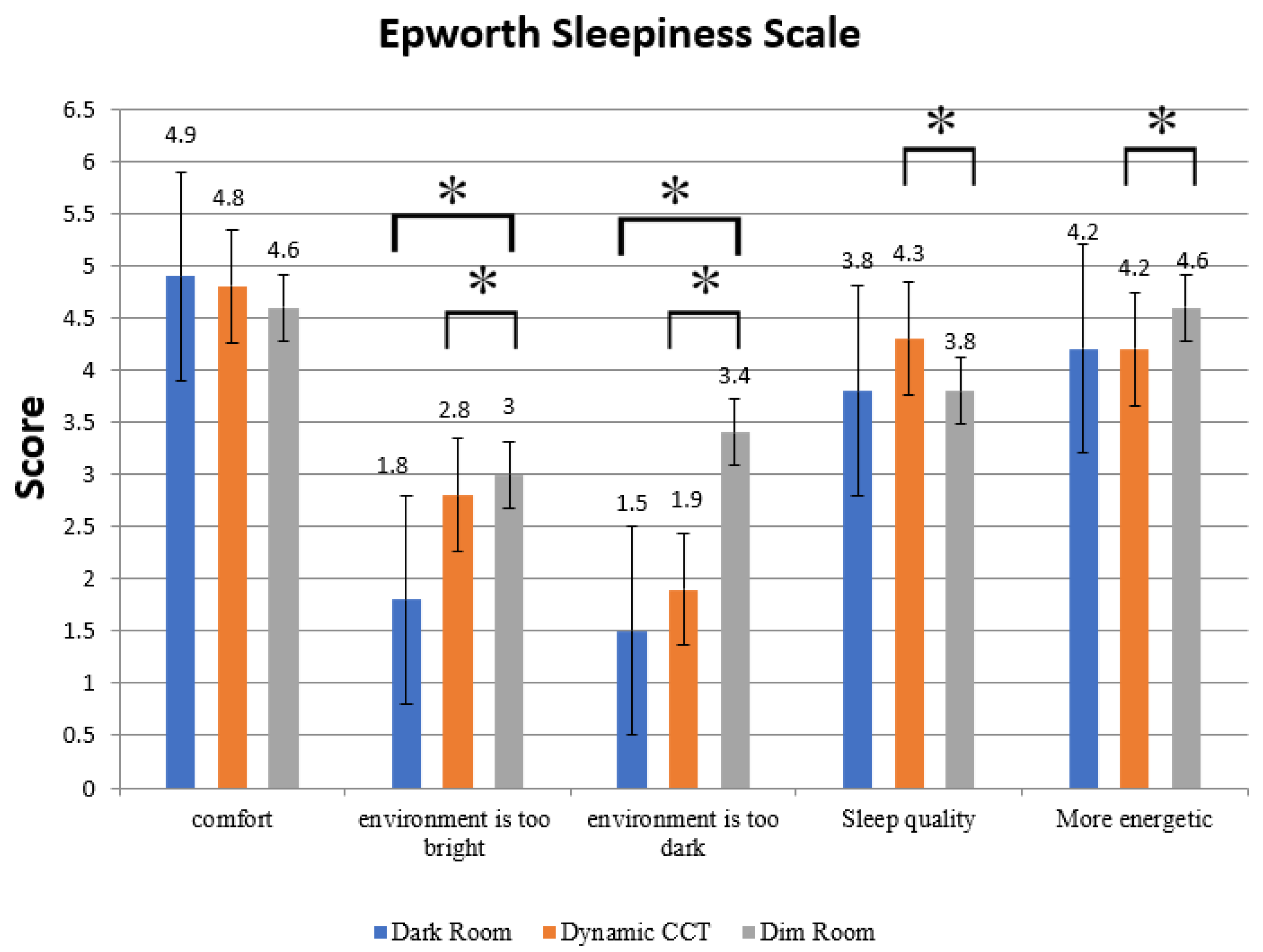
| Time | Task |
|---|---|
| 11:10–11:40 | Lunch |
| 11:40–11:45 | Environmental adaptation |
| 11:45–11:50 | Wear ECG electrode patch |
| 11:50–12:00 | Typing task |
| 12:00–13:00 | Sleep experiment |
| 13:00–13:10 | Typing task |
| 13:10–13:15 | Psychological questionnaire |
| Score | ||||||
|---|---|---|---|---|---|---|
| Comfort | 1 | 2 | 3 | 4 | 5 | 6 |
| Environment is too bright | 1 | 2 | 3 | 4 | 5 | 6 |
| Environment is too dark | 1 | 2 | 3 | 4 | 5 | 6 |
| Sleep quality | 1 | 2 | 3 | 4 | 5 | 6 |
| More energetic | 1 | 2 | 3 | 4 | 5 | 6 |
Publisher’s Note: MDPI stays neutral with regard to jurisdictional claims in published maps and institutional affiliations. |
© 2022 by the authors. Licensee MDPI, Basel, Switzerland. This article is an open access article distributed under the terms and conditions of the Creative Commons Attribution (CC BY) license (https://creativecommons.org/licenses/by/4.0/).
Share and Cite
Chen, C.-Y.; Chen, H.-W. The Effect of Dynamic Lighting for Working Shift People on Clinical Heart Rate Variability and Human Slow Wave Sleep. Appl. Sci. 2022, 12, 2284. https://doi.org/10.3390/app12052284
Chen C-Y, Chen H-W. The Effect of Dynamic Lighting for Working Shift People on Clinical Heart Rate Variability and Human Slow Wave Sleep. Applied Sciences. 2022; 12(5):2284. https://doi.org/10.3390/app12052284
Chicago/Turabian StyleChen, Chien-Yu, and Hung-Wei Chen. 2022. "The Effect of Dynamic Lighting for Working Shift People on Clinical Heart Rate Variability and Human Slow Wave Sleep" Applied Sciences 12, no. 5: 2284. https://doi.org/10.3390/app12052284
APA StyleChen, C.-Y., & Chen, H.-W. (2022). The Effect of Dynamic Lighting for Working Shift People on Clinical Heart Rate Variability and Human Slow Wave Sleep. Applied Sciences, 12(5), 2284. https://doi.org/10.3390/app12052284






